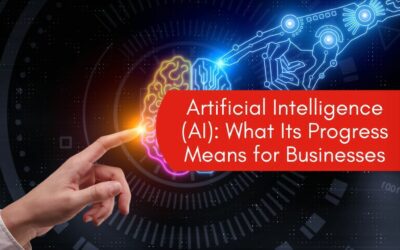WHAT IS ARTIFICIAL INTELLIGENCE?
The world is changing at an unprecedented speed. Our society and economy have witnessed more profound changes in the last century than at any other time before. At the core of this transformation are a set of critical technologies, spearheaded by Artificial Intelligence, also known as AI.
AI has one goal: to take the principles that govern how the human brain operates and apply them to computing. It represents a massive departure from traditional computing, where a human needs to feed the machine an input, output, and logic. With AI, the computer only needs an input – it is then able to figure out the rest by itself.
Many think of AI as a concept from science-fiction. But this technology is not something that we might encounter in the distant future – it is very much here already! AI has given us machine learning, deep learning, and neural networks, techniques that are shaping the world, from marketing to art and entertainment, and from the way we shop to how we interact.
The impact of AI on today’s world is profound and cannot be overstated. This tech is changing the way we manufacture, ship, market, and use products. Facebook, Netflix, and Amazon, to name but a few, rely on AI to create algorithms capable of predicting consumer behavior accurately.
A host of techniques associated with AI are being used across the whole spectrum of industries and areas of human endeavor. However, broadly speaking, we can divide AI into four categories according to the levels of complexity involved:
– Reactive machines that use data to draw conclusions. An excellent example of this is chess engines
– Machines that use live data to interpret a situation and make decisions, such as self-driving cars
– The so-called ‘theory of mind:’ Systems that understand that every entity possesses its own set of underlying principles—motives, intentions, and emotions. This level of AI hasn’t been reached yet
– Self-aware machines. This is the final stage—AI that knows of the existence of other systems, and it is also aware of its own.
MACHINE LEARNING
In the early days, AI technology relied on hard-cord rules and algorithms. When you played chess against a machine, its response was determined by looking ahead at every possible series of moves and choosing the one with the best outcome. Those moves had to be entered ahead of time by a programmer. This type of AI may seem intelligent, but it has no ability to learn based on its own experience.
Machine learning flipped that on its head. Instead of relying on rules to make decisions, a machine learning algorithm is trained by feeding it real-world data. Machine learning creates a model that looks for patterns between the data you supply and what you are trying to predict. As the machine is exposed to more data, its accuracy invariably improves, reaching the point where it can predict things it has never seen before.
Say you want to build a system that predicts how much you can sell your used car for using machine learning. You’d start by feeding the algorithm historical data of used car sales, together with information like the vehicle model, the year of manufacture, or the mileage. Based on that information, the algorithm builds a model that understands how each property affects the car’s price. This model can then be used to determine how much the car will sell for. As more data is fed to the system, it only becomes more and more accurate.
DEEP LEARNING & NEURAL NETWORKS
A subset of machine learning, deep learning has attracted attention due to its flexibility. The technique is inspired by human brains. Deep learning systems are composed of layers of virtual ‘neurons.’ Each neuron is tasked with merely adding up the inputs coming into it and deciding whether to fire off a signal to the next layer of neurons.
Every neuron in a layer is connected to every neuron in the layers of the network above and below. This neural network can solve a wide variety of problems, in much the same human brains do. The sheer number of connections between neurons means they can represent very complex problems.
Deep learning has applications in every industry. In the medical field, for example, it is being used to help doctors diagnose lung cancer. The Chinese startup Infervision is using deep learning and image recognition to diagnose possible lung cancer with X-rays more accurately and efficiently than ever before.
CHATBOTS
Conversational AI, also known as chatbots, is another technology that has taken the world by storm in the last few years. Chatbots allow companies to quickly and efficiently address customers’ main queries and problems. These programs have reached such a level of complexity that, in many cases, it is genuinely hard to tell them apart from humans.
As they replace humans, these chatbots are saving companies millions of dollars in salaries, all the while improving the customer experience immensely. The most advanced chatbots are capable of answering open-ended questions very much as a human would.
An excellent example of a company that uses this technology is Sephora, the French cosmetics manufacturer. Visitors to its website can “try on” its lipstick and eyeshadow on a photo of themselves that they share with a bot. The bot’s AI technology identifies the user’s facial features and uses augmented reality to apply these makeup tests.
Machines can be very good at specific tasks, surpassing humans in many capacities. For example, modern chess engines that run on supercomputers are capable of defeating even the most skilled human players. However, there is no machine today with the depth and breadth of skills and cognition that human brains are capable of.




